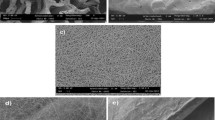Abstract
This research work aims to propose highly porous polymer/bioactive glass composites as potential scaffolds for hard-tissue and soft-tissue engineering. The scaffolds were prepared by impregnating an open-cells polyurethane sponge with melt-derived particles of a bioactive glass belonging to the SiO2–P2O5–CaO–MgO–Na2O–K2O system (CEL2). Both the starting materials and the composite scaffolds were investigated from a morphological and structural viewpoint by X-ray diffraction analysis and scanning electron microscopy. Tensile mechanical tests, carried out according to international ISO and ASTM standards, were performed by using properly tailored specimens. In vitro tests by soaking the scaffolds in simulated body fluid (SBF) were also carried out to assess the bioactivity of the porous composites. It was found that the composite scaffolds were highly bioactive as after 7 days of soaking in SBF a HA layer grew on their surface. The obtained polyurethane/CEL2 composite scaffolds are promising candidates for tissue engineering applications.








Similar content being viewed by others
References
Schlickewei W, Schlickewei S. The use of bone substitutes in the treatment of bone defects—the clinical view and history. Macromol Symp. 2007;253:10–23. doi:10.1002/masy.200750702.
Wu L, Ding J. In vitro degradation of three-dimensional porous poly(D,L -lactide-co-glycolide) scaffolds for tissue engineering. Biomaterials. 2004;25:5821–30. doi:10.1016/j.biomaterials.2004.01.038.
Lin ASP, Barrows TH, Cartmell SH, Guldberg RE. Microarchitectural and mechanical characterization of oriented porous polymer scaffolds. Biomaterials. 2003;24:481–9. doi:10.1016/S0142-9612(02)00361-7.
Wolff D, Goldberg VM, Stevenson S. Histomorphometric analysis of the repair of a segmental diaphyseal defect with ceramic and titanium fibermetal implants: effects of bone marrow. J Orthop Res. 1994;12:439–46. doi:10.1002/jor.1100120317.
Kon E, et al. Autologous bone marrow stromal cells loaded onto porous hydroxyapatite ceramic accelerate bone repair in critical-size defects of sheep long bones. J Biomed Mater Res. 2000;49:328–37. doi:10.1002/(SICI)1097-4636(20000305)49:3<328::AID-JBM5>3.0.CO;2-Q.
Fredericks DC, et al. Segmental bone defect repair using sintered, porous ceramics. Key Eng Mater. 2002;218–220:409–12. doi:10.4028/www.scientific.net/KEM.218-220.409.
Wilson CE, et al. A new in vivo screening model for posterior spinal bone formation: comparison of ten calcium phosphate ceramic material treatments. Biomaterials. 2002;27:302–14. doi:10.1016/j.biomaterials.2005.06.041.
Marcacci M, et al. Stem cells associated with macroporous bioceramics for long bone repair: 6- to 7-year outcome of a pilot clinical study. Tissue Eng. 2007;13:947–55. doi:10.1089/ten.2006.0271.
Ozawa N, Negami S, Odaka T, Morii T, Koshino T. Histological observations on tissue reaction of the rat calcaneal tendon to sintered hydroxyapatite. J Mater Sci Lett. 1989;8:869–71. doi:10.1007/BF01729929.
LeGeros RZ. Biodegradation and bioresorption of calcium phosphate ceramics. Clin Mater. 1993;14:65–88. doi:10.1016/0267-6605(93)90049-D.
LeGeros RZ, Lin S, Rohanizadeh R, Mijares D, LeGeros JP. Biphasic calcium phosphate bioceramics: preparation, properties and applications. J Mater Sci: Mater Med. 2003;14:201–9. doi:10.1023/A:1022872421333.
Hench LL. Bioactive materials: the potential for tissue regeneration. J Biomed Mater Res. 1998;41:511–8. doi:10.1002/(SICI)1097-4636(19980915)41:4<511::AID-JBM1>3.0.CO;2-F.
Hench LL. Biomaterials: a forecast for the future. Biomaterials. 1998;19:1419–23. doi:10.1016/S0142-9612(98)00133-1.
Jones JR, Ehrenfried LM, Hench LL. Optimising bioactive glass scaffolds for bone tissue engineering. Biomaterials. 2006;27:964–73. doi:10.1016/j.biomaterials.2005.07.017.
Knowles JC. Phosphate based glasses for biomedical applications. J Mater Chem. 2003;13:2395–401. doi:10.1039/b307119g.
Abou EA, Knowles JC. Physical and biocompatibility studies of novel titanium dioxide doped phosphate-based glasses for bone tissue engineering applications. J Mater Sci: Mater Med. 2008;19:377–86. doi:10.1007/s10856-007-3079-5.
Khan YM, Katti DS, Laurencin CT. Novel polymer-synthesized ceramic composite-based system for bone repair: an in vitro evaluation. J Biomed Mater Res A. 2004;69:728–37.
Zhang RY, Ma PX. Poly(-hydroxyl acids)/hydroxyapatite porous composites for bone-tissue engineering. I. Preparation and morphology. J Biomed Mater Res. 1999;44:446–55. doi:10.1002/(SICI)1097-4636(19990315)44:4<446::AID-JBM11>3.0.CO;2-F.
Stamboulis AG, Hench LL, Boccaccini AR. Mechanical properties of biodegradable polymer sutures coated with bioactive glass. J Mater Sci: Mater Med. 2002;4:843–8. doi:10.1023/A:1016544211478.
Bretcanu O, Chen Q, Misra SK, Boccaccini AR, Roy I, Verné E, Vitale-Brovarone C. Biodegradable polymer coated 45S5 Bioglass-derived glass-ceramic scaffolds for bone tissue engineering. Glass Technol Eur J Glass Sci Technol A. 2007;48:227–34.
Verrier S, Blaker JJ, Maquet V, Hench LL, Boccaccini AR. PDLLA/Bioglass® composites for soft-tissue and hard-tissue engineering: an in vitro cell biology assessment. Biomaterials. 2004;25:3013–21. doi:10.1016/j.biomaterials.2003.09.081.
Hench LL. The story of Bioglass®. J Mater Sci: Mater Med. 2006;17:967–78. doi:10.1007/s10856-006-0432-z.
ASTM D638-08. Standard test method for tensile properties of plastics.
ISO 527-1:1993 standard. Plastics—determination of tensile properties.
ASTM F2150-07. Standard guide for characterization and testing of biomaterial scaffolds used in tissue-engineered medical products.
Zhang K, Wang Y, Hillmayer MA, Francis LF. Processing and properties of porous poly( -lactide)/bioactive glass composites. Biomaterials. 2004;25:2489–500. doi:10.1016/j.biomaterials.2003.09.033.
Vitale-Brovarone C, Verné E, Robiglio L, Martinasso G, Canuto RA, Muzio G. Biocompatible glass–ceramic materials for bone substitution. J Mater Sci: Mater Med. 2008;19:471–8. doi:10.1007/s10856-006-0111-0.
Karageorgiou V, Kaplan D. Porosity of 3D biomaterial scaffolds and osteogenesis. Biomaterials. 2005;26:5474–91. doi:10.1016/j.biomaterials.2005.02.002.
Kenesei P, Kadar Cs, Rajkovits Zs. The influence of cell-size distribution on the plastic deformation in metal foams. J Lendvai Scr Mater. 2004;50:295–300. doi:10.1016/j.scriptamat.2003.09.046.
Kokubo T, Takadama H. How useful is SBF in predicting in vivo bone bioactivity? Biomaterials. 2006;27:2907–15. doi:10.1016/j.biomaterials.2006.01.017.
Rezwan K, Chen QZ, Blaker JJ, Boccaccini AR. Biodegradable and bioactive porous polymer/inorganic composite scaffolds for bone tissue engineering. Biomaterials. 2006;27:3413–31. doi:10.1016/j.biomaterials.2006.01.039.
Jones J, Hench LL. Regeneration of trabecular bone using porous ceramics. Curr Opin Solid State Mater Sci. 2003;7:301–7. doi:10.1016/j.cossms.2003.09.012.
Bil M, Ryszkowska J, Roether JA, Bretcanu O, Boccaccini AR. Bioactivity of polyurethane-based scaffolds coated with Bioglass®. Biomed Mater. 2007;2:93–101. doi:10.1088/1748-6041/2/2/006.
Ciardelli G, et al. Bioactive polyurethanes in clinical applications. Polym Adv Technol. 2006;17:786–9. doi:10.1002/pat.781.
Acknowledgements
The authors gratefully acknowledge the financial support of Regione Piemonte (Ricerca Sanitaria Finalizzata) supplied for this work.
Author information
Authors and Affiliations
Corresponding author
Rights and permissions
About this article
Cite this article
Baino, F., Verné, E. & Vitale-Brovarone, C. Feasibility, tailoring and properties of polyurethane/bioactive glass composite scaffolds for tissue engineering. J Mater Sci: Mater Med 20, 2189–2195 (2009). https://doi.org/10.1007/s10856-009-3787-0
Received:
Accepted:
Published:
Issue Date:
DOI: https://doi.org/10.1007/s10856-009-3787-0




